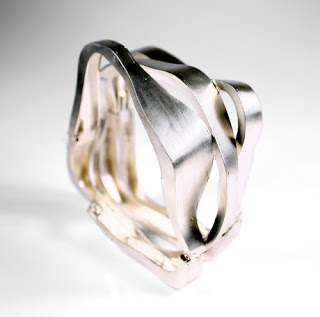Farrah Al-Dujaili
Farrah Al-Dujaili lived in United Kingdom, were she is working independently as jewellery design maker in a studio. She recently finished an MA at The School of Jewellery at Birmingham. She has been selected for “MEDITERRANEO” an international contemporary jewellery exhibition. The colours and marine life of the Mediterranean inspired the selected piece ‘Codium very l lara’, and she was also one of ninety five designer makers to be selected to exhibit at Talente at the International Trade Fair in Munich in March this year.
Her design methodology revolves around the act of drawing as an intuitive and subconscious process; geometric and organic components ‘grow’ alongside each other to create visual contrasts. Through a palette of feminine and masculine symbols, heavily detailed flowers and geometric shapes and crosshatched lines hybrid forms are created; not overtly floral, but organic and playful.
She is making immersed in metalwork because of the material’s ability to be visually delicate but physically strong. Fragments are created and later constructed to create the idiosyncratic detailing that appears in my drawings. She works within an intuitive mix of drawing and making that crosses over and intertwines.
Her drawing materials are pencils, crayons and watercolours to a surface of enamel paints. This gives an interesting material link to her design methodology, enforcing the dialogue between drawing and making.
Farrah Al-Dujaili
Brooch: Untitled 2010
Copper, enamel paint, watercolor pencil
17 x 18 x 7 cm
A brooch: This piece is simpler in vision which also illustrates the geometric and organic shape of a cylinder in 3d, and 2d circles and rectangles, attached with few lines; frames are produced by these lines around it. It is light in mass and more balanced the way it has been designed.
Farrah Al-Dujaili
Necklace: Untitled 2011
Copper, enamel paint, watercolour, pastel, thread
9.5 x 23 x 4 cm
Necklace: It’s symmetrically, twisted or kind of a waves, crossed lines on the oval organic path which also doesn’t look balanced the way I see it and the is a space that takes place in this piece.
Farrah Al-Dujaili
Brooch: Untitled 2011
Copper, enamel paint, watercolour, watercolour pencil, pastel
5.5 x 4 x 2 cm
Brooch: Also Geometric and organic, it has a feeling of being spiky, pretty balanced by the circle underneath on the left with the spikes on the right top corner, lining has been used and space, also symmetrically with the contrast of colour happening in there too, and also gives some un even square shapes.
Mari Ishikawa
Mari Ishikawa was born in 1964, in Kyoto, Japan. She attained her Masters Degree of Art at Nara University of Education in Japan (1982-86), then studied jewellery making at Hiko Mizuno Collage of Jewellery also in Japan (1993-94). She is currently residing in Germany where she also studied jewellery at the Munich- Academy of Fine Art (1994-2000).
She has worked in public collections at the Museum of art and design, New York, USA and she has been awarded The Award of “Bayerischer Staat Preise in 2010”. She has done her solo exhibit of the “Moon Light Shadow” 2009.
Mari Ishikawa
Ring: Moonlight Shadow 2009
Gold 750, Silver 925
8 x 6,5 x 4 cm
Ring: Depth of volume on the insertion path, seems quite a bit heavier, texture is smooth. It is also well balanced by the organic leaves with a gold wiring line running across the other side of the ring.
Mari Ishikawa
Necklace: Moonlight Shadow 2008
Silver 925
58 x 9 x 4 cm
Necklace: The chain seems to be spiky, the pendent is like made from a bark of a tree with small flowers on and it is patined, shows some colour. It is a bit rough too.
Mari Ishikawa
Brooch: Moonlight Shadow 2008
Silver 925, Diamond
10,5 x 6,5 x 2,5 cm
Brooch: It has leaves behind the bark and a line that is crossing on the right which I think it’s a root, the bark has a rough texture and wide on size which makes it more rectangle, it’s light on mass.
References
2. crafthays.ning.com/../farrahaldujaili
































